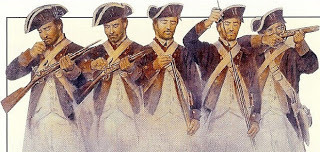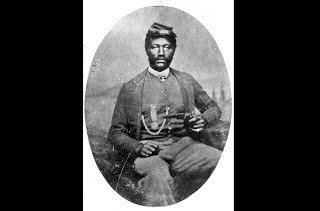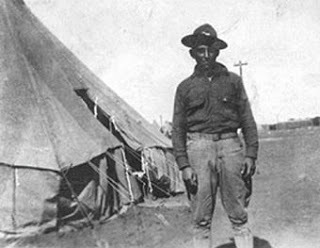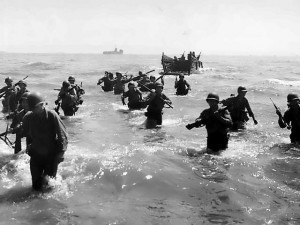Nancy Moser's Blog, page 5
July 27, 2012
Then and Now...
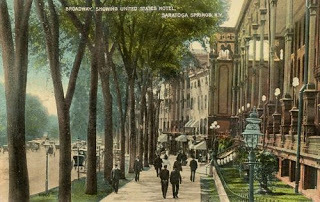 I’m writing this blog from Saratoga Springs, New York. The birthplace of racing, the place where the rich from New York City went to get away from the crowding, the summer heat, and the bad city air. If they wanted the beach they went to Newport, Rhode Island, if they wanted racing and the Adirondack Mountains, they went to Saratoga Springs
I’m writing this blog from Saratoga Springs, New York. The birthplace of racing, the place where the rich from New York City went to get away from the crowding, the summer heat, and the bad city air. If they wanted the beach they went to Newport, Rhode Island, if they wanted racing and the Adirondack Mountains, they went to Saratoga Springs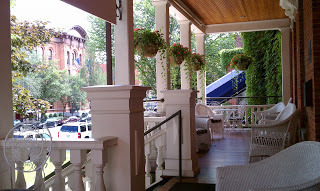 Porch at Saratoga ArmsThe main street of Broadway still boasts many of the buildings that were around in the 1870’s to 1890’s. Our hotel, The Saratoga Arms used to be a men’s boarding house.
Porch at Saratoga ArmsThe main street of Broadway still boasts many of the buildings that were around in the 1870’s to 1890’s. Our hotel, The Saratoga Arms used to be a men’s boarding house.The evening was perfect, around 70 degrees, and I sat on a bench to people watch. And then I closed my eyes and tried to picture myself back 120-40 years, as a woman sitting on a similar bench, on this very street. I’ve always marveled in how women are essentially the same now as in the past.
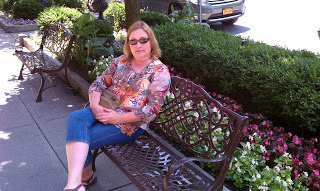 Essentially maybe, but not as much as I thought. The differences assailed me:
Essentially maybe, but not as much as I thought. The differences assailed me:1. I was sitting alone, waiting for my husband. In 1880, as a woman of bearing (let’s just assume my 1880’s woman is wealthy) I would never have ventured down the street alone without a male companion as my chaperon.
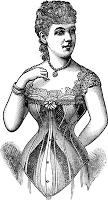 2. As you see in the photo, I’m relaxed and casual. Comfortable is the key word. In 1880 I would’ve been wearing a corset, and would sport a bustle. No slumping allowed!
2. As you see in the photo, I’m relaxed and casual. Comfortable is the key word. In 1880 I would’ve been wearing a corset, and would sport a bustle. No slumping allowed!3. I’m sitting with my legs crossed. No proper 1880 lady sat in such a manner. And risk exposing her ankle? Never.
4. I’m wearing denim capris. Only workmen wore denim (thank you Levi Strauss—in 1873), no women ever wore pants, much less ones that revealed their bare calf and ankle. Brazen Nancy!
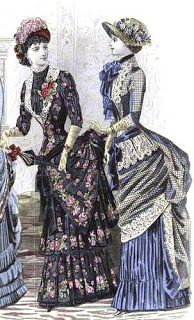 5. I wore a voile blouse. Comfy and cool. An 1880’s woman would have worn a dress or a blouse and skirt, to her ankles, with frilly sleeves and collar, perhaps made out of gabardine or cambric or silk. And underneath she would wear the corset, bustle, a corset cover, pantaloons, and a bevy of petticoats or underskirts. Although it was only 70 degrees on this day in Saratoga Springs, two days earlier, it was an unseasonal 100! How did the people of 1880 deal with that kind of heat? (I don’t know. I can’t imagine!)
5. I wore a voile blouse. Comfy and cool. An 1880’s woman would have worn a dress or a blouse and skirt, to her ankles, with frilly sleeves and collar, perhaps made out of gabardine or cambric or silk. And underneath she would wear the corset, bustle, a corset cover, pantaloons, and a bevy of petticoats or underskirts. Although it was only 70 degrees on this day in Saratoga Springs, two days earlier, it was an unseasonal 100! How did the people of 1880 deal with that kind of heat? (I don’t know. I can’t imagine!)6. Getting down to the issue of sweat… I’m pretty sure I didn’t offend anyone by my smell. But in 1880? Before deodorants sanitized our nasal palate? And with clothes that weren’t washable? I can’t imagine the aroma of the past.
7. I wore sandals with rubber bottoms, and expensive arches that keep my back from hurting when I walk a lot. In 1880 the ladies wore button-up shoes with hard soles, and of course stockings to above their knees.
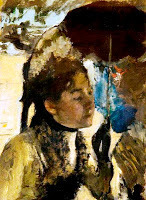
8. I wore sunglasses to deal with the glare—prescription, bi-focal sunglasses so I can see far away and read. In 1880 sunglasses were rare. But I would have had a parasol.
9. I sat there with a bare head. In 1880 I would have worn a hat—and not just a visor.
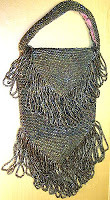
10. I carried a purse containing a credit card, driver’s license, insurance card, makeup, money, phone… I collect antique purses and the ones that I have from this era are delicate and often made of beads. They could hold a small compact for powder, and perhaps a few coins. The women didn’t carry money. The men paid for everything. Sounds good to me.
 `
`11. My skin was pampered with wrinkle cream with SPF to protect my face from the harmful rays of the sun, my hands with lotion, my heels with foot cream, and my lips with Chapstick. In 1880 face cream and lotions were around, often homemade, but they were often greasy, and certainly didn’t make wrinkles go away (though I’m not sure the stuff we use now achieves that either.)
12. I took a shower this morning and dried my hair with a hair-dryer. Special, magical Ions made the frizz go away (sort of.) The woman of 1880 might have had a bath in her hotel—whether full or just a hip bath—but it was a big production that involved servants lugging hot water up many stairs. Many hotels, even the nice ones, only had one bathroom down the hall that needed to be shared. If you needed to go potty in the middle of the night? Pull out the chamber pot. But I have questions: were there public restrooms? What did people do when they needed to go? And how did they manage it wearing the many-layers of clothes?
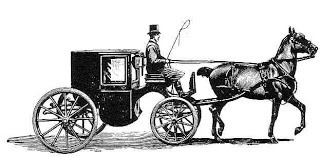 13. The sounds of passing cars invaded the moment, but in 1880 it wouldn’t have been any quieter. Horses and carriages on cobblestones, whinnying, the sound of whips and drivers yelling at their steeds and other drivers. I read that the width of Broadway was determined by how much space was needed for a horse and carriage to turn-around.
13. The sounds of passing cars invaded the moment, but in 1880 it wouldn’t have been any quieter. Horses and carriages on cobblestones, whinnying, the sound of whips and drivers yelling at their steeds and other drivers. I read that the width of Broadway was determined by how much space was needed for a horse and carriage to turn-around.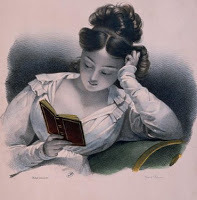 14. Now on to my thoughts… Sitting on the bench I was contemplating an idea for a new business that my husband and I had been discussing. In 1880 most women weren’t interested in business, nor would they be consulted about any such decisions. Not because they weren’t smart enough or able enough, but because it just wasn’t a possibility for most of them. What did they think about? What excited them intellectually? What did a woman do when she had aspirations and ambition? Did she sit and stew about it? Or did she make waves? Or… was the idea of her limited place in society so deeply ingrained that she didn’t let such a thought cross her mind at all?
14. Now on to my thoughts… Sitting on the bench I was contemplating an idea for a new business that my husband and I had been discussing. In 1880 most women weren’t interested in business, nor would they be consulted about any such decisions. Not because they weren’t smart enough or able enough, but because it just wasn’t a possibility for most of them. What did they think about? What excited them intellectually? What did a woman do when she had aspirations and ambition? Did she sit and stew about it? Or did she make waves? Or… was the idea of her limited place in society so deeply ingrained that she didn’t let such a thought cross her mind at all?15. I had a caffeine headache and took an Excedrin—with water from my water bottle. The 1880 woman might have some headache powder, but she would have had to go back to her lodging to take it. And carrying around water 24/7? Forgeddaboutit.
16. Then I started thinking about my cell phone, checking the weather forecast, my email, reading reviews of restaurants and things-to-do… we can’t even venture into that arena, as there was no comparable opportunities for quick information in 1880.
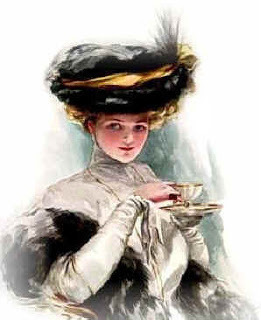 17. Speaking of eating… we’d just gotten back from eating at a Mexican restaurant. Mentioning that cuisine, our 1880 woman might ask, “What kind of restaurant?” Burritos, enchiladas, and margaritas were beyond her realm of knowledge and taste.
17. Speaking of eating… we’d just gotten back from eating at a Mexican restaurant. Mentioning that cuisine, our 1880 woman might ask, “What kind of restaurant?” Burritos, enchiladas, and margaritas were beyond her realm of knowledge and taste.Detailing the differences between myself and my fellow female in 1880 made me rather sad. Although I often say I would have loved to wear those luscious clothes and go to balls, and be courted and pampered for my femininity, when it comes down to the nitty-gritty listed above, I don’t think I’d trade places with her. Our lives today are so incredibly at-ease, with choices and ways to give ourselves comfort so we don’t need to suffer heat, pain, thirst, hunger, and lack of opportunity. We are capable and able to get (or at least try for) anything our minds and hearts can imagine.
With this knowledge I vow to appreciate more and complain less.
Oooh, there’s a frozen yogurt shop across the street . . .//Nancy
Published on July 27, 2012 05:00
July 13, 2012
Victorian Servants and Their Uniforms
 I’m writing a novel about a Victorian manor house, and came upon an interesting tidbit—one that I didn’t believe at first. For it makes no sense.
I’m writing a novel about a Victorian manor house, and came upon an interesting tidbit—one that I didn’t believe at first. For it makes no sense.When a girl became a maid of any sort—whether kitchen or chambermaid—she had to provide her own uniforms. A black dress and white apron for formal occasions when she was seen by the public, and a simpler dress to wear when she was doing the hard work. This would cost between £4-5 (equivalent to £228-285 today, or $354-442.) In 1900, with a yearly wage of only £22 pounds (£1255/ $1948) she had to provide her own clothes? She had to spend nearly 20% of her first year’s wage on her uniforms. They also had to do their work wearing a corset. No thank you. Ever, actually.
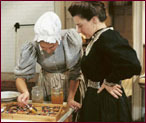 The Lady’s Maid, who was often of some social position, usually knew a bit about fashion so they could be of use in advising, dressing, (and mending) their mistress’ clothing. They could wear normal clothing, even castoffs from her mistress (£32 (£1824/$2831.)
The Lady’s Maid, who was often of some social position, usually knew a bit about fashion so they could be of use in advising, dressing, (and mending) their mistress’ clothing. They could wear normal clothing, even castoffs from her mistress (£32 (£1824/$2831.)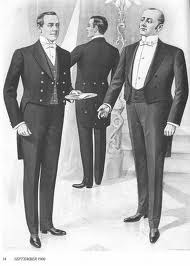
The Housekeeper, earning £45 (£2567/$3985), usually wore a dark dress, and the butler--the highest paid at £60 (£3423/$5314)—wore a formal black suit. The cook (who I would consider the most important servant) earned £40 (£2282/$3543.)
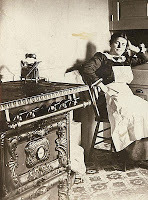 Their employers only paid for the uniforms of the footmen—the fancy-dancy livery. The footmen were paid £26 a year (£1484/$2304.) The fancier the livery, the more status for the family. They even were given a stipend to pay for the powder for their hair. So the footmen, who made decent money, didn’t have to pay for anything. No wonder they often had a haughty attitude. And if they were over six foot tall? They got paid extra. And if they were a matching pair…zounds. Now that was something to brag
Their employers only paid for the uniforms of the footmen—the fancy-dancy livery. The footmen were paid £26 a year (£1484/$2304.) The fancier the livery, the more status for the family. They even were given a stipend to pay for the powder for their hair. So the footmen, who made decent money, didn’t have to pay for anything. No wonder they often had a haughty attitude. And if they were over six foot tall? They got paid extra. And if they were a matching pair…zounds. Now that was something to brag
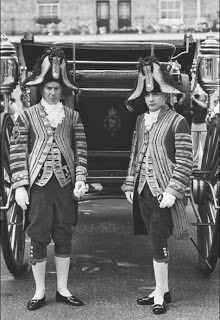 about. Having good calves was also important and some footmen wore "falsies" to pad their lacking calves. It looks like the two in the photo at the right could have used a little extra padding. Sorry, chaps. I'm just calling them as I see them.
about. Having good calves was also important and some footmen wore "falsies" to pad their lacking calves. It looks like the two in the photo at the right could have used a little extra padding. Sorry, chaps. I'm just calling them as I see them.Just to give you the full picture, the lowest position was the scullery maid, who made £12 (£685 /$1063.). And the lowest male position of hallboy got £16 (£913 $1417.)
I’m still learning about servants—and there’s so much to learn. But paying for uniforms? That seems unfair. And yet… I remember working in a restaurant that had a uniform, and I had to purchase it. But no way did it cost 20% of my annual income.
The good thing about being a servant is that their room and board was provided, so they had few expenses. But they also had little time off and had to suffer the heirarchy of their employers--and the strict heirarchy of their own servant-world (more on that in another post.)
I’ll also be writing more about the duties of servants later. But I can tell you now, I’m very happy I've never had to empty a chamber pot.//Nancy
Published on July 13, 2012 04:00
July 2, 2012
An Antique Weed
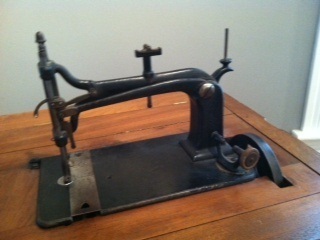 Every year since my now thirty-something daughter was about twelve years old, she and I and an assortment of friends have spent the Friday before Father’s Day in Walnut, Iowa, at the annual flea market there. We do our best to get there as soon as vendors are open to do business, and we stay until they begin to fold up their tents (almost literally, sometimes). I’ve never worn a pedometer, but my aching knees and feet are testimony to the fact that the day includes a few miles of walking, punctuated by a pause to eat lunch at the Methodist Church lunch tent—and pie. Gooseberry, if I’m lucky. Then, on the drive home, we stop for a meal and share “war stories” from the day of haggling and treasure-hunting. And of course we have a grown-up version of “show and tell.” Over the years, I’ve brought home quilts, quilt blocks, feed sacks, silver charms, stereoscope cards (I love to find ones of places in Europe I’ve visited), and my personal favorite—characters for my novels in the guise of those old sepia toned photographs. The silver charms were a passion of my daughter’s childhood. Other phases have included windows from old houses, architectural finials and corbels, and … vintage suit cases. Books are a perennial favorite. This year I changed my mind on a beautiful volume titled The Life and Times of D.L. Moody. The reason I didn’t buy it was that it was $2 until I handed over the money … and then the dealer showed me the “real” price … $50. I don’t mind a mark-up, but that seemed a bit much. And I gotta admit I was disappointed that the dealer hadn’t bothered to erase her purchase price before indicating her own price on another page. Sigh. I’ll read about Moody another way. I think that one of the reasons I love “old stuff,” though, is the connection it provides to women from the past. And this year I made a connection that I’ll treasure for many years to come. I bought a weed. Sewing machine. I was attracted to the machine—at the back of a vendor’s spot on the street—because of the simplicity of the design. When I got closer, I realized that once it was “put away,” the machine would look like an end table. The cabinet is lovely, the foot pedals intricately formed. And it works.
Every year since my now thirty-something daughter was about twelve years old, she and I and an assortment of friends have spent the Friday before Father’s Day in Walnut, Iowa, at the annual flea market there. We do our best to get there as soon as vendors are open to do business, and we stay until they begin to fold up their tents (almost literally, sometimes). I’ve never worn a pedometer, but my aching knees and feet are testimony to the fact that the day includes a few miles of walking, punctuated by a pause to eat lunch at the Methodist Church lunch tent—and pie. Gooseberry, if I’m lucky. Then, on the drive home, we stop for a meal and share “war stories” from the day of haggling and treasure-hunting. And of course we have a grown-up version of “show and tell.” Over the years, I’ve brought home quilts, quilt blocks, feed sacks, silver charms, stereoscope cards (I love to find ones of places in Europe I’ve visited), and my personal favorite—characters for my novels in the guise of those old sepia toned photographs. The silver charms were a passion of my daughter’s childhood. Other phases have included windows from old houses, architectural finials and corbels, and … vintage suit cases. Books are a perennial favorite. This year I changed my mind on a beautiful volume titled The Life and Times of D.L. Moody. The reason I didn’t buy it was that it was $2 until I handed over the money … and then the dealer showed me the “real” price … $50. I don’t mind a mark-up, but that seemed a bit much. And I gotta admit I was disappointed that the dealer hadn’t bothered to erase her purchase price before indicating her own price on another page. Sigh. I’ll read about Moody another way. I think that one of the reasons I love “old stuff,” though, is the connection it provides to women from the past. And this year I made a connection that I’ll treasure for many years to come. I bought a weed. Sewing machine. I was attracted to the machine—at the back of a vendor’s spot on the street—because of the simplicity of the design. When I got closer, I realized that once it was “put away,” the machine would look like an end table. The cabinet is lovely, the foot pedals intricately formed. And it works.
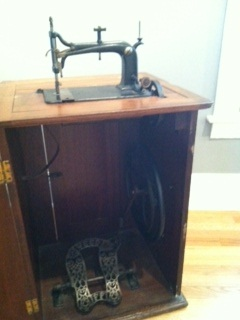 But the best thing about the machine was the fragments of 19th century calico in the tool bin … the attachments … the “1871” pressed into the cabinet … and the fact that the dealer had the original manual. It’s a “Family Favorite” model. The manual was copyrighted in 1875, and some of the parts have patent dates as early as 1856. I’m fascinated. I’ve already ‘sprung’ for a page from an 1868 NY City Directory advertising this machine. And a trade card. Both for sale on ebay. I’ve talked to treadle machine enthusiasts and learned that my “weed” was made in Hartford, Connecticut. The machine works. And now it’s sitting to the left of my desk where I can wonder about all the women who’ve made work shirts and dresses and aprons and … maybe … quilts seated at this machine. And I’m already looking forward to next year’s caravan to 2013 edition of the Walnut, Iowa, flea market. Memories for sale … and memories made. Fun time with my girls. Priceless. ---Stephanie
But the best thing about the machine was the fragments of 19th century calico in the tool bin … the attachments … the “1871” pressed into the cabinet … and the fact that the dealer had the original manual. It’s a “Family Favorite” model. The manual was copyrighted in 1875, and some of the parts have patent dates as early as 1856. I’m fascinated. I’ve already ‘sprung’ for a page from an 1868 NY City Directory advertising this machine. And a trade card. Both for sale on ebay. I’ve talked to treadle machine enthusiasts and learned that my “weed” was made in Hartford, Connecticut. The machine works. And now it’s sitting to the left of my desk where I can wonder about all the women who’ve made work shirts and dresses and aprons and … maybe … quilts seated at this machine. And I’m already looking forward to next year’s caravan to 2013 edition of the Walnut, Iowa, flea market. Memories for sale … and memories made. Fun time with my girls. Priceless. ---Stephanie
Published on July 02, 2012 21:07
June 17, 2012
Mary Riggs and the Dakota War of 1862
Last week I talked about a few of the pioneer women I’ve “met” who encourage me when I feel discouraged. This week I thought I’d share a little more about one of those women and how her story ended up in one of my stories. Her name was Mary Longley Riggs. I “met” her one day when I was browsing biographies at the library. An old book drew my attention, “oldstufflover” that I am. The title gave me goosebumps. I’d been researching the Dakota War of 1862, but I’d finished for the day, browsing and creating an ever more impossible “I want to read this someday” list. (Do you have one of those? I bet we all do.)
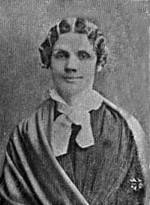 Well. That old book? Mary and I, Forty Years with the Sioux, an autobiographical account of Mary and Stephen Return Riggs, who “just happened” to be a missionaries among the Dakota Sioux during the Dakota War of 1862. Within the pages of that book, I met yet another woman who is on my list of “invite her to coffee in heaven someday.” (Do you have a list like that, too? Mine keeps getting longer. But I’ll have time. Ha.) What made me admire Mrs. Riggs more than anything was the fact that she willingly stepped WAY out of her personal “comfort zone” to answer God’s call on her life. She’d attended schools in Massachusetts and begun to teach when only sixteen years old. Eventually, though, she was teaching “in the west” when “the west” meant Ohio. In Ohio she met Stephen Riggs. The couple eventually journeyed into “the far west” and begin housekeeping in a 10 x 18 foot room on the upper level of a log dwelling at Lac Qui Parle, Minnesota. Mary wrote, “We fixed it up with loose boards overhead, and quilts nailed up to the rafters, and improvised a bedstead … that room we made our home for five winters … there our first three children were born … and there, with what help I could obtain, I prepared for the printer the greater part of the New Testament in the language of the Dakotas.”
Well. That old book? Mary and I, Forty Years with the Sioux, an autobiographical account of Mary and Stephen Return Riggs, who “just happened” to be a missionaries among the Dakota Sioux during the Dakota War of 1862. Within the pages of that book, I met yet another woman who is on my list of “invite her to coffee in heaven someday.” (Do you have a list like that, too? Mine keeps getting longer. But I’ll have time. Ha.) What made me admire Mrs. Riggs more than anything was the fact that she willingly stepped WAY out of her personal “comfort zone” to answer God’s call on her life. She’d attended schools in Massachusetts and begun to teach when only sixteen years old. Eventually, though, she was teaching “in the west” when “the west” meant Ohio. In Ohio she met Stephen Riggs. The couple eventually journeyed into “the far west” and begin housekeeping in a 10 x 18 foot room on the upper level of a log dwelling at Lac Qui Parle, Minnesota. Mary wrote, “We fixed it up with loose boards overhead, and quilts nailed up to the rafters, and improvised a bedstead … that room we made our home for five winters … there our first three children were born … and there, with what help I could obtain, I prepared for the printer the greater part of the New Testament in the language of the Dakotas.”
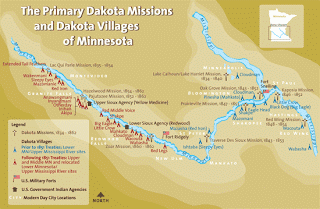 The work of white missionaries among Native Americans is a subject of controversy, and I understand that, but I still admire Mary Riggs. The Riggses didn’t force their students to abandon their language. Instead, they translated God’s Word and wrote text books in Dakota. Dakota men risked their lives to see the Riggses to safety during the Dakota War. Those heroic efforts inspired me to create Daniel Two Stars, the Dakota hero of my Dakota Moons series. Mary Riggs had a difficult time learning another language. She was made fun of more than once for it. That had to have been hard for a young woman who had once taught school in Ohio. Her first home in Minnesota burned to the ground, but Native women came to help, sharing what they had with the young mother from a different world. Mary Riggs raised several children, most of whom also became missionaries—a daughter to China and others among Native Americans in the West.
The work of white missionaries among Native Americans is a subject of controversy, and I understand that, but I still admire Mary Riggs. The Riggses didn’t force their students to abandon their language. Instead, they translated God’s Word and wrote text books in Dakota. Dakota men risked their lives to see the Riggses to safety during the Dakota War. Those heroic efforts inspired me to create Daniel Two Stars, the Dakota hero of my Dakota Moons series. Mary Riggs had a difficult time learning another language. She was made fun of more than once for it. That had to have been hard for a young woman who had once taught school in Ohio. Her first home in Minnesota burned to the ground, but Native women came to help, sharing what they had with the young mother from a different world. Mary Riggs raised several children, most of whom also became missionaries—a daughter to China and others among Native Americans in the West. 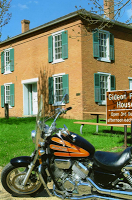 A few years ago, I received a call from a member of the Gideon Pond Society, asking me to come to Minnesota and speak on my research (Agnes and Gideon Pond were early missionaries in the area as well). It’s a great memory, and I’m thrilled that my three novels, which have been out of print for a long time, will soon be back IN print and available as ebooks. (Valley of the Shadow, Edge of the Wilderness, and Heart of the Sandhills all feature Genevieve LaCroix, a half-French, half-Dakota student at the Dakota Missions and her true love, Daniel Two Stars.)
A few years ago, I received a call from a member of the Gideon Pond Society, asking me to come to Minnesota and speak on my research (Agnes and Gideon Pond were early missionaries in the area as well). It’s a great memory, and I’m thrilled that my three novels, which have been out of print for a long time, will soon be back IN print and available as ebooks. (Valley of the Shadow, Edge of the Wilderness, and Heart of the Sandhills all feature Genevieve LaCroix, a half-French, half-Dakota student at the Dakota Missions and her true love, Daniel Two Stars.)Here’s Kitty parked in front of the Gideon Pond House in Minneapolis. What would Mrs. Riggs and Mrs. Pond have thought of that!
Hope your Father's Day weekend is going well and that our Heavenly Father blesses your day.--Stephanie
Published on June 17, 2012 13:00
June 8, 2012
Public speaking and the historical fiction author
Stephanie will be sharing her presentation "Calico Trails in Falls City, Nebraska, on Tuesday, June 12.Falls City Library & Arts Center1400 Stone StreetFalls City, Nebraska. Supper at 5:30 (call 402/245-2913 to make a reservation) or come to the library at 7:00 p.m. for the free presentation
The first time someone asked me if I did public speaking as a writer, I was shocked. Of course not. I’m a historical fiction author. I hide in the library and study dead people. And then I play—alone—with imaginary friends to write a story based on the people I’ve “met”—alone—at the library. Or the museum. Or the historical society archives.
Eventually, though, I realized that I had, after all, led women’s Bible studies at church on occasion, and maybe I should give it a try. Why not take the opportunity to share what God has done in my life? So I developed my personal testimony as my first talk. I called it “A Patchwork Life,” and I used some of my old quilts to illustrate the talk—not only as a visual aid, but also as a way to make people look at something besides the speaker shaking in her boots over being up in front of a bunch of strangers.
Many writers—perhaps most of the writers I know—are actually introverts. Oh, they write and lecture and teach, but they get their energy from being alone. Since writers spend a lot of time alone, that’s probably a good thing, but it also fools a lot of people about who we really all when no one is watching. Happy to be alone. Not just at peace with silence but often energized by it.
This next Tuesday evening, I’m taking my “show on the road” so to speak and giving my Calico Trails presentation at the Falls City, Nebraska, Library and Arts Center. This is one of my favorite talks, because it includes LOTS of quilts and hence, less of me in the spotlight. I get to share what pioneer women’s lives were like in their own words, sharing some of the things I’ve read in their diaries and reminiscences over the years, and once again I’ll get to celebrate the women who have encouraged me, all the way from the 19th century.
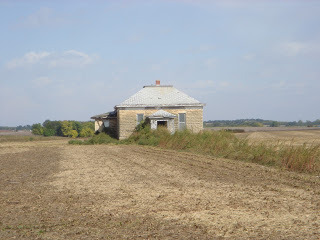 Couldn't resist getting out of the car and taking this photo in Kansas. Martha Mott wrote home, asking if her parents might have some old clothes they could send her so she could make her little boy a coat. And then apologized for bothering them. I discovered her letters home in the archive here in Nebraska, and delighted as I met a sister in Christ who spoke often of her faith in a personal God. Of praying for rain, and praising God when it came. Or didn’t. Grandmother Newton worked the farm alone while her beloved husband was away during the Civil War, and then wrote of making thirty-one quilts to give her descendents as “something to remember me by.” Her great grandson lovingly preserved her letters and entrusted them to me for a season of study. Katie Maze ended up using the box her father had made for her kitchen utensils as a casket for a child she lost to diphtheria. I bought her out of print memoir from a rare book dealer, and then enjoyed the serendipity of seeing a quilt she made in a local collection. Emily Carpenter wrote in her diary, “Huldah sick and I care nothing about cattle.” (Emily’s family was making the trek west with a sizeable herd of cattle.) I read a fragment of Emily’s diary tucked into an archival file named for someone else.
Couldn't resist getting out of the car and taking this photo in Kansas. Martha Mott wrote home, asking if her parents might have some old clothes they could send her so she could make her little boy a coat. And then apologized for bothering them. I discovered her letters home in the archive here in Nebraska, and delighted as I met a sister in Christ who spoke often of her faith in a personal God. Of praying for rain, and praising God when it came. Or didn’t. Grandmother Newton worked the farm alone while her beloved husband was away during the Civil War, and then wrote of making thirty-one quilts to give her descendents as “something to remember me by.” Her great grandson lovingly preserved her letters and entrusted them to me for a season of study. Katie Maze ended up using the box her father had made for her kitchen utensils as a casket for a child she lost to diphtheria. I bought her out of print memoir from a rare book dealer, and then enjoyed the serendipity of seeing a quilt she made in a local collection. Emily Carpenter wrote in her diary, “Huldah sick and I care nothing about cattle.” (Emily’s family was making the trek west with a sizeable herd of cattle.) I read a fragment of Emily’s diary tucked into an archival file named for someone else.
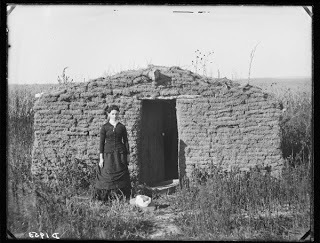 Miss Mary Longfellow, Custer County, Nebraska
Miss Mary Longfellow, Custer County, Nebraska
courtesy of Nebraska State Historical SocietyI once had a friend who said that if it had been up to her to settle the American West, we’d all still be in Boston drinking tea. The more I learn about the women of the 19thcentury West, the more I am inclined to agree with her. I’m a hardy soul, but I have my limits … and I think life in a sod house on a rainy day with a sick baby would have reached it. Except, of course, for God’s grace, which enabled those women, just as it enables me today. And that’s what I love about learning about the women of the past. They encourage me. They give me perspective. They remind me that, as poet Roy Lessin wrote, “The God who helped you in the past, is the one who’s faithful still.”
If you can join me in Falls City, Nebraska, please do! Falls City Library & Arts Center, 1400 Stone Street, Falls City, Nebraska. Supper at 5:30 (call 402/245-2913 to make a reservation) or come to the library at 7:00 p.m. for the free presentation. I’d love to meet you and introduce you to a few of the real women who continue to inspire my imaginary friends.
If you love reading about the real women of the past, try the Covered Wagon Women collection of actual Oregon Trail Diaries. Or No Time on My Hands, Grace Snyder’s memoir. Or something by historians Lillian Schlissel or Joanna Stratton. If you’re like me, you’ll be newly grateful for your dishwasher, your doctor, your refrigerator, your furnace, your spider spray, and light bulbs. I’m really thankful for light bulbs. And indoor plumbing. And … those women who endured.

The first time someone asked me if I did public speaking as a writer, I was shocked. Of course not. I’m a historical fiction author. I hide in the library and study dead people. And then I play—alone—with imaginary friends to write a story based on the people I’ve “met”—alone—at the library. Or the museum. Or the historical society archives.
Eventually, though, I realized that I had, after all, led women’s Bible studies at church on occasion, and maybe I should give it a try. Why not take the opportunity to share what God has done in my life? So I developed my personal testimony as my first talk. I called it “A Patchwork Life,” and I used some of my old quilts to illustrate the talk—not only as a visual aid, but also as a way to make people look at something besides the speaker shaking in her boots over being up in front of a bunch of strangers.
Many writers—perhaps most of the writers I know—are actually introverts. Oh, they write and lecture and teach, but they get their energy from being alone. Since writers spend a lot of time alone, that’s probably a good thing, but it also fools a lot of people about who we really all when no one is watching. Happy to be alone. Not just at peace with silence but often energized by it.
This next Tuesday evening, I’m taking my “show on the road” so to speak and giving my Calico Trails presentation at the Falls City, Nebraska, Library and Arts Center. This is one of my favorite talks, because it includes LOTS of quilts and hence, less of me in the spotlight. I get to share what pioneer women’s lives were like in their own words, sharing some of the things I’ve read in their diaries and reminiscences over the years, and once again I’ll get to celebrate the women who have encouraged me, all the way from the 19th century.
 Couldn't resist getting out of the car and taking this photo in Kansas. Martha Mott wrote home, asking if her parents might have some old clothes they could send her so she could make her little boy a coat. And then apologized for bothering them. I discovered her letters home in the archive here in Nebraska, and delighted as I met a sister in Christ who spoke often of her faith in a personal God. Of praying for rain, and praising God when it came. Or didn’t. Grandmother Newton worked the farm alone while her beloved husband was away during the Civil War, and then wrote of making thirty-one quilts to give her descendents as “something to remember me by.” Her great grandson lovingly preserved her letters and entrusted them to me for a season of study. Katie Maze ended up using the box her father had made for her kitchen utensils as a casket for a child she lost to diphtheria. I bought her out of print memoir from a rare book dealer, and then enjoyed the serendipity of seeing a quilt she made in a local collection. Emily Carpenter wrote in her diary, “Huldah sick and I care nothing about cattle.” (Emily’s family was making the trek west with a sizeable herd of cattle.) I read a fragment of Emily’s diary tucked into an archival file named for someone else.
Couldn't resist getting out of the car and taking this photo in Kansas. Martha Mott wrote home, asking if her parents might have some old clothes they could send her so she could make her little boy a coat. And then apologized for bothering them. I discovered her letters home in the archive here in Nebraska, and delighted as I met a sister in Christ who spoke often of her faith in a personal God. Of praying for rain, and praising God when it came. Or didn’t. Grandmother Newton worked the farm alone while her beloved husband was away during the Civil War, and then wrote of making thirty-one quilts to give her descendents as “something to remember me by.” Her great grandson lovingly preserved her letters and entrusted them to me for a season of study. Katie Maze ended up using the box her father had made for her kitchen utensils as a casket for a child she lost to diphtheria. I bought her out of print memoir from a rare book dealer, and then enjoyed the serendipity of seeing a quilt she made in a local collection. Emily Carpenter wrote in her diary, “Huldah sick and I care nothing about cattle.” (Emily’s family was making the trek west with a sizeable herd of cattle.) I read a fragment of Emily’s diary tucked into an archival file named for someone else. Miss Mary Longfellow, Custer County, Nebraska
Miss Mary Longfellow, Custer County, Nebraskacourtesy of Nebraska State Historical SocietyI once had a friend who said that if it had been up to her to settle the American West, we’d all still be in Boston drinking tea. The more I learn about the women of the 19thcentury West, the more I am inclined to agree with her. I’m a hardy soul, but I have my limits … and I think life in a sod house on a rainy day with a sick baby would have reached it. Except, of course, for God’s grace, which enabled those women, just as it enables me today. And that’s what I love about learning about the women of the past. They encourage me. They give me perspective. They remind me that, as poet Roy Lessin wrote, “The God who helped you in the past, is the one who’s faithful still.”
If you can join me in Falls City, Nebraska, please do! Falls City Library & Arts Center, 1400 Stone Street, Falls City, Nebraska. Supper at 5:30 (call 402/245-2913 to make a reservation) or come to the library at 7:00 p.m. for the free presentation. I’d love to meet you and introduce you to a few of the real women who continue to inspire my imaginary friends.
If you love reading about the real women of the past, try the Covered Wagon Women collection of actual Oregon Trail Diaries. Or No Time on My Hands, Grace Snyder’s memoir. Or something by historians Lillian Schlissel or Joanna Stratton. If you’re like me, you’ll be newly grateful for your dishwasher, your doctor, your refrigerator, your furnace, your spider spray, and light bulbs. I’m really thankful for light bulbs. And indoor plumbing. And … those women who endured.
Published on June 08, 2012 13:56
June 1, 2012
Mozart's Sister
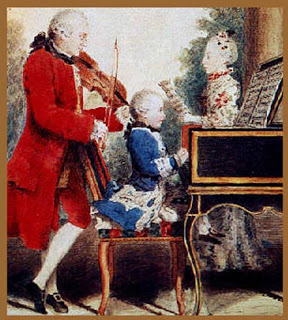 Did you know Mozart had an older sister who was just as talented as he was? But because she was a woman she didn't have a chance to fully utilize her talent.
Did you know Mozart had an older sister who was just as talented as he was? But because she was a woman she didn't have a chance to fully utilize her talent.How sad.
I heard these two facts a few years ago when I was touring Mozart's house in Salzburg, Austria. Even though I was on tourist overload, I remembered them, and, long story short, ended up writing a biographical novel, Mozart's Sister.
What's a biographical novel--or bio-novel, for short? In my case, I define them as novels that are factual (as much as I can make them so) but read like a novel. It's a chance for my ladies-of-history to speak, to tell their life-stories.
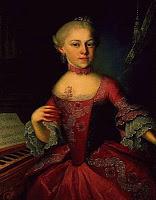 Nannerl, age 11
Nannerl, age 11 Nannerl Mozart was five years older than her little brother, Wolfgang. Their father, Leopold, worked for the archbishop in Salzburg, Austria, with the music program at the cathedral. His talent went beyond music, to being able to see talent in others--in his son and daughter.
And so at the age of 5 and 10, Leopold and his wife took their children on a grand musical tour, to Vienna, Paris, London, Holland, Germany . . . They performed before royalty, in castles and palaces. Beyond the normal music, they did tricks like playing with a cloth over the keys. The aristocracy of Europe loved them. Their father readily accepted gifts and payment, though what they'd receive as compensation--and when they'd receive it--was a surprise.
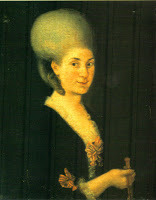 But then . . . they grew. What was magical as children became less so as adolescents. Leopold began to lie about their age. Imagine being a young girl, blossoming into a woman and not being able to take joy in it because because the simple act of growing up annoyed her father and cut into the family income.
But then . . . they grew. What was magical as children became less so as adolescents. Leopold began to lie about their age. Imagine being a young girl, blossoming into a woman and not being able to take joy in it because because the simple act of growing up annoyed her father and cut into the family income.While Leopold struggled with money, status, and his own delicate ego, Nannerl was literally left behind. With money tight, and the children's star waning, their father focused on the son alone. Even though Nannerl could compose and was an expert at accompanying--without music--there were no women composers, so she was not encouraged. Women were supposed to take care of the home, get married, and have babies. He used her talent as long as it made him money, then pushed her aside.
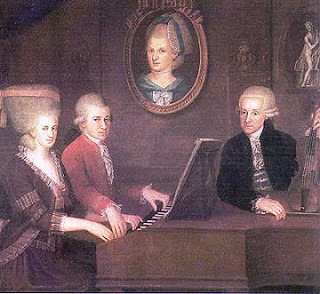 The Mozarts, notice Mrs. Mozart shown in a portrait,
The Mozarts, notice Mrs. Mozart shown in a portrait, after she diedAs for the other woman in the Mozart family? Nannerl and Wolfgang's mother, Maria Anna, was virtually a footnote to history. She lived, she bore these talented children, but then she died in Paris while being a reluctant chaperone to her teenage son who considered her a bother.
I often think about women in history, and the roles they were forced to play. Not that being a wife and mother isn't admirable (I enjoy both roles!) but to not have any choices . . . that's what I find sad. Consider your own talents and ambitions. What if they had no outlet? What if you were discouraged from developing them to their fullest potential? I wouldn't take that well. Yet if a choice wasn't even an option . . . perhaps it was easier for these women of the past. Their roles were clear. Today, our roles are the ones that can grow fuzzy and complicated. Perhaps they didn't mind?
 Salzburg, Austria
Salzburg, AustriaI think it was hard for Nannerl because she was shown the world and was initially encouraged in her music. To have all that taken from her would be more painful than never having it at all.
And yet, I do believe she found happiness and fulfillment--though not as she expected. Isn't that often the way? When one door closes we are usually given the chance to find another path toward our purpose. Rocky roads are not impassable, they just take an extra dose of determination.
Read Nannerl's life-story in Mozart's Sister at Amazon or Barnes & Noble. Her father insisted that they keep all their correspondence, so I was often able to use their own words in the telling of the story. How better to hear a family's history?
If you'd like to read about other women-of history, check out my other bio-novels: Just Jane (Jane Austen), Washington's Lady (Martha Washington), and How Do I Love Thee? (Elizabeth Barrett Browning.) //Nancy
Published on June 01, 2012 05:00
May 28, 2012
Memorial Day
Published on May 28, 2012 13:49
May 7, 2012
The Horsford Cook Book, 1895
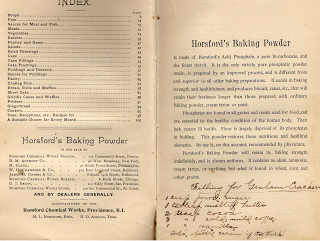 I realize that your world doesn't revolve around whether or not I blog about history, but it's been a MONTH and I feel a need to 'splain.
I realize that your world doesn't revolve around whether or not I blog about history, but it's been a MONTH and I feel a need to 'splain.This next Saturday I will be taking a walk in a funny hat. To receive my M.A. in historical studies. YEE-HAWWWWW! So that's my excuse for abandoning the blog for a while, although I haven't abandoned history. In fact, my 70-page final "paper" involved designing an eight-week undergraduate course on "Great Plainwomen to 1950." And did I ever meet some amazing women designing that course! In coming weeks, I'll introduce some of them. The course does an overview of the Great Plains, and then segues into one week each studying indigenous women, homesteaders, educators, military women, business women, political activists, and religious leaders. Just this past week I transcribed a few pages of an 1836 diary written by Eliza Wilcox Merrill, the wife of Moses Merrill. Together, the Merrills founded a school for Otoe Indian children in what would one day be Nebraska. Reading Mrs. Merrill's diary connected me with a sister in Christ I look forward to meeting one day.
IN THE MEANTIME ... don't you just love opening an old book and finding something handwritten from the past? That happened to me this past week as I sought a historical recipe to share in an upcoming novel. I can't help but wonder who wrote the above recipe for "Filling for Graham Crackers" on the page opposite this little book. My dear mother-in-law gave me The Horsford Cook Book by Fannie Merritt Farmer, principal of the Boston Cooking School, many years ago. It's a very fragile 107 page book that measures only 4 x 6 1/2 inches. At the bottom of the title page, one reads, "The publisher will send a copy of this book free, postpaid, on receipt of four labels from the bottom of the can of Horsford's Baking Powder." So I wonder whether the original owner paid 50 cents (the price that's listed) or saved up labels to get hers free.
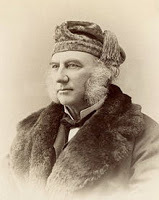 I haven't given much thought to early improvements in things like baking powder, but Eben Horsford, who was quite the advocate for women's education (and was connected to Albany Female Academy and Wellesley College in his lifetime) actually became quite successful when he reformulated baking powder and created a more reliable product. He also improved condensed milk.
I haven't given much thought to early improvements in things like baking powder, but Eben Horsford, who was quite the advocate for women's education (and was connected to Albany Female Academy and Wellesley College in his lifetime) actually became quite successful when he reformulated baking powder and created a more reliable product. He also improved condensed milk. Fannie Farmer is credited with standardizing measurements in recipes and thereby assuring more reliable results. The year after Rumford Chemical Works published this little cook book in my collection, the first edition of the still-in-print Fannie Farmer Cookbook was published.
Farmer's note in my little cook book references the issue of standardizing measurements, as she explains, "A cupful of dry ingredients is a level cupful. A cupful of liquid is all that the cup will hold. Butter and lard should be packed solidly into the cup."
Today I made the graham cracker filling.
1 cup powd. sugar1 tablesp. melted butter2 teasp. cocoa3 teasp. cold, mild coffee1 teasp. vanillaAdd little cream if too thick.
It reminded me a little of Nutella, and the consistency would make it great frosting for cupcakes. I think I'd like it better if the coffee flavor were stronger ... and if I used European butter. Overall, though, I give this little recipe a "thumbs up," and the thing I like most about it is that I can pronounce every single ingredient and actually know what they all are.
One thing I find fascinating about the cookbook is the fact that baking directions are nonexistent. For example:
Cream Almond Cake
1 cup butter 2 cups flour2 cups sugar 2 level teasponfuls Horsford's Baking Powder1 cup milk 5 egg whites1 cup cornstarch 1-2 teaspoonful almond extract
Cream the butter, add gradually the sugar, add the almond. mix and sift the flour, cornstarch and baking powder. Add alternately with the milk to the first mixture. Beat the whites until stiff; add, and beat vigorously. This makes two loaves.
Oh ... really? What size? And how long do I bake them? And at what temperature? I don't suppose 19th century ovens had temperature control, so I understand that, but it seems that we'd at least be given a hint. "Moderate oven for X minutes" or "until a knife inserted comes out clean" ... or something?!
Still, that cream almond cake sounds good ....
The little book concludes with "A Suitable Dinner for Every Month." The menu for MAY is:
Tomato Soup. Croutons.Baked Shad.Sauce Hollandaise.Saratoga Chips.Lettuce and Radish Salad.Bread and Butter Pudding.Cold Sauce.
Bon appetit!.......................................................................................................................Stephanie
Published on May 07, 2012 18:09
April 6, 2012
Human History's Crowning Event
This weekend we'll be commemorating the single most important event in all of human history. A first century itinerant teacher's death. But don't forget the rest of that bit of history. Jesus wasn't just a great teacher. He also created the known universe. He was the only One who could solve my sin problem, and He did it ... and then He proved it by leaving the empty tomb. Imagine. Climbing out of one's own grave. The ultimate "it is finished." I've spent a great part of my adult life trying to wrap my brain around that concept and I just can't do it. Faith has to step in at some point, because it just isn't humanly comprehensible. Which is OK by me. Who needs a God they can explain.
Yesterday as I was scraping off the layer of "I'm finishing this book and I need that ... all of it ... right here" which usually creates a nest of stacks of research in the center of which I sit furiously pounding away ... I listened to a new album by Jason Gray. And when it came to the song "A Way to See in the Dark," I sat down. Reached for the lyrics. And replayed it. And I imagined the apostles gathered in a dark place. Hiding away ... and wishing they could see a way through the darkness that descended with Jesus--their hope--lay in a tomb. Thought I'd share that song with you as part of this unconventional post.
_______________________________________
In one of my former lives I was a secretary at the University of Nebraska (back in the day we were still called secretaries). One of my bosses was a devout Roman Catholic whose wife wrote an award-winning column for the local newspaper. I'd like to share her 1986 column about Easter. It isn't intended to spoil the fun ... fun is great ("He gives us all good things to richly enjoy"). But it's also a challenge to remember the primary purpose for this season we celebrate every spring. Mrs. Costello was the mother of a tribe of kids, and I hear her challenging herself with these words. To remember the primary purpose. Wisdom from over a quarter of a century ago by one Mary Costello:___________________________________ Two thousand years ago, an itinerant preacher was hanged as a common criminal. He died on some trumped-up charges, probably because he was different. Mainly, the problem was he didn't fit in with those in authority, and they were afraid of him. He was going around the countryside doing some strange things and stirring up trouble. So they thought they'd better get rid of him--as quickly and as efficiently as possible.
And that's how we continue to commemorate his death--as quickly and efficiently as possible. "Oh, yes. Good Friday. I remember that. But I have to work."
This man, who was God, died for us. To redeem us, and to bring us to his father. And we remember his death with pink stuffed bunnies and chocolate eggs.
 He was tortured, hung on a cross with nails in his hands and feet. He was beat with a whip and tortured with a helmet of nails pushed into his scalp. I'll try to remember that between commercials on "Miami Vice" Friday night.
He was tortured, hung on a cross with nails in his hands and feet. He was beat with a whip and tortured with a helmet of nails pushed into his scalp. I'll try to remember that between commercials on "Miami Vice" Friday night.
His mother placed him in the tomb and arranged the clothes around him with her own hands. Well, some businesses do close at noon on Good Friday.
After three days in the tomb, the preacher rose from the dead. It was the most magnificent, glorious miracle in the history of mankind. To celebrate that event, I'll get all the kids new shoes.
It was an event that changed the course of history, for all time. It was the focal point, the turning point of man's existence. "Church on Easter. Yes, that would be nice. All the little girls in their bonnets and pink sweaters. But we'll probably just sleep in--haven't had a Sunday off in ages."
His resurrection says to us: "Have hope. I love you. I came to save you; to bring you to heaven with me." So we dig out the little plastic baskets, fill them with green plastic grass and arrange chocolate eggs and jelly beans. Jelly beans have become a great symbol of hope to all Americans. Does that strike you as strange?
To everyone he met, after he rose and left the tomb, he said, "My peace be with you." In memory of that, and to bring peace into my own life, I will spend the entire week before Easter dashing around town, buying candy and eggs and shoes and new stockings to match dresses that will only be worn once, and we will spend Sunday eating too much and fighting over who ate all the marshmallow chicks.
His friends were so happy to see him, they cried. They understood. Between the egg hunt and the ham and scalloped potatoes, if I have a minute, I'll try to remember how they felt.
He lived and died for us, so that we might have life everlasting, but also so that our lives could be filled with hope and peace and joy. In the weeks after Easter--when the world is filled with new life and tiny blue lilac buds, and palest green grass and all the wonders spring brings to us--I'll try to remember his life, and what it has taught me. I hope it's more than pink stuffed bunnies.________________________________
Blessed Easter to you and yours from Stephanie!

Yesterday as I was scraping off the layer of "I'm finishing this book and I need that ... all of it ... right here" which usually creates a nest of stacks of research in the center of which I sit furiously pounding away ... I listened to a new album by Jason Gray. And when it came to the song "A Way to See in the Dark," I sat down. Reached for the lyrics. And replayed it. And I imagined the apostles gathered in a dark place. Hiding away ... and wishing they could see a way through the darkness that descended with Jesus--their hope--lay in a tomb. Thought I'd share that song with you as part of this unconventional post.
_______________________________________
In one of my former lives I was a secretary at the University of Nebraska (back in the day we were still called secretaries). One of my bosses was a devout Roman Catholic whose wife wrote an award-winning column for the local newspaper. I'd like to share her 1986 column about Easter. It isn't intended to spoil the fun ... fun is great ("He gives us all good things to richly enjoy"). But it's also a challenge to remember the primary purpose for this season we celebrate every spring. Mrs. Costello was the mother of a tribe of kids, and I hear her challenging herself with these words. To remember the primary purpose. Wisdom from over a quarter of a century ago by one Mary Costello:___________________________________ Two thousand years ago, an itinerant preacher was hanged as a common criminal. He died on some trumped-up charges, probably because he was different. Mainly, the problem was he didn't fit in with those in authority, and they were afraid of him. He was going around the countryside doing some strange things and stirring up trouble. So they thought they'd better get rid of him--as quickly and as efficiently as possible.
And that's how we continue to commemorate his death--as quickly and efficiently as possible. "Oh, yes. Good Friday. I remember that. But I have to work."
This man, who was God, died for us. To redeem us, and to bring us to his father. And we remember his death with pink stuffed bunnies and chocolate eggs.
 He was tortured, hung on a cross with nails in his hands and feet. He was beat with a whip and tortured with a helmet of nails pushed into his scalp. I'll try to remember that between commercials on "Miami Vice" Friday night.
He was tortured, hung on a cross with nails in his hands and feet. He was beat with a whip and tortured with a helmet of nails pushed into his scalp. I'll try to remember that between commercials on "Miami Vice" Friday night.His mother placed him in the tomb and arranged the clothes around him with her own hands. Well, some businesses do close at noon on Good Friday.
After three days in the tomb, the preacher rose from the dead. It was the most magnificent, glorious miracle in the history of mankind. To celebrate that event, I'll get all the kids new shoes.
It was an event that changed the course of history, for all time. It was the focal point, the turning point of man's existence. "Church on Easter. Yes, that would be nice. All the little girls in their bonnets and pink sweaters. But we'll probably just sleep in--haven't had a Sunday off in ages."
His resurrection says to us: "Have hope. I love you. I came to save you; to bring you to heaven with me." So we dig out the little plastic baskets, fill them with green plastic grass and arrange chocolate eggs and jelly beans. Jelly beans have become a great symbol of hope to all Americans. Does that strike you as strange?
To everyone he met, after he rose and left the tomb, he said, "My peace be with you." In memory of that, and to bring peace into my own life, I will spend the entire week before Easter dashing around town, buying candy and eggs and shoes and new stockings to match dresses that will only be worn once, and we will spend Sunday eating too much and fighting over who ate all the marshmallow chicks.
His friends were so happy to see him, they cried. They understood. Between the egg hunt and the ham and scalloped potatoes, if I have a minute, I'll try to remember how they felt.
He lived and died for us, so that we might have life everlasting, but also so that our lives could be filled with hope and peace and joy. In the weeks after Easter--when the world is filled with new life and tiny blue lilac buds, and palest green grass and all the wonders spring brings to us--I'll try to remember his life, and what it has taught me. I hope it's more than pink stuffed bunnies.________________________________
Blessed Easter to you and yours from Stephanie!
Published on April 06, 2012 13:49
March 17, 2012
St. Patrick's Day
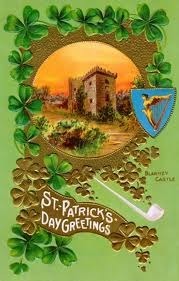
Happy St. Patrick's Day! Are you wearin' green today?
What little I know about my own heritage includes mostly Scots and Germans, but my brother-in-law is the official poet of the Higgins clan (for true) and so I've married into a family that has strong ties, although we haven't dyed any rivers green of late.
A few years ago, the family geneaologist (Grandpa Jack), his two sons, and his grandson did a tour of the Emerald Isle in search of family ties. At one point they began calling it the "No More Ruined Abbeys Tour," but they had a wonderful time and came home agreeing that it was an unforgettable journey that made them feel even more connected to their roots in County Clare.
I'm actually sitting in my office today sporting my husband's black SORT (Special Operations Response Team) T-shirt editing my next book in the Quilt Chronicles series, but I can't allow the day to pass without a nod to ancient history.
Here's a link that I found fascinating regarding who Saint Patrick was:
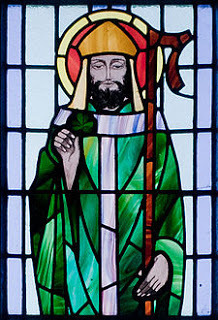
http://www.history.com/topics/who-was-saint-patrick
And a note from the Huffington Post about St. Patrick's Day in America: "St. Patrick's Day is deeply rooted in American soil. As early as the mid-nineteenth century, lavish and elaborate St. Patrick's parades were an annual fixture ... These parades tended to be not only Irish but emphatically Catholic
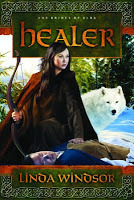 As to ancient history of the British Isles, I highly recommend Linda Windsor's book Healer, which takes place in ancient times and imparts an amazing amount of knowledge about the history of Christianity in the British Isles. I just finished it this week, and was moved to tears by some of the beautiful accounts of faith in action.
As to ancient history of the British Isles, I highly recommend Linda Windsor's book Healer, which takes place in ancient times and imparts an amazing amount of knowledge about the history of Christianity in the British Isles. I just finished it this week, and was moved to tears by some of the beautiful accounts of faith in action.I've been fascinated by King Arthur and Camelot since the days when Richard Harris and Franco Nero were vying for Queen Guinevere's heart. That was 1967. It seems about ten minutes ago. Two years later, I wrote a research paper comparing Le Morte d'Arthur with The Once and Future King. The cover of that paper tells me that I wrote it for "English 8A" and turned it in on May 12, 1969:
"Volumes have been written about the reign of one King Arthur who, with his unpredictable Queen Guinevere, tried to create a new civilization at Camelot. And then came Sir Lancelot du Lake. The tragedy of the eternal triangle created when Guinevere and Lancelot fall in love has been interpreted by countless writers. Herein, Sir Thomas Mallory's Le Morte D'arthur, written in the 1400s, will be compared with T.H. White's The Once and Future King, written in 1939 ..." and so on for fifteen double-spaced typewritten pages.
Do you remember Franco Nero? He ended up married to the actress who played Queen Guinevere, Vanessa Redgrave. And I never forgot those blue eyes and enjoyed seeing them reunited in the film "Letters to Juliet" in 2010. Plucks at the romantic heartstrings, it does.
Well, I've gone far afield from St. Patrick's Day, haven't I. I'll re-circle and end with this wonderful prayer from St. Patrick.
I bind to myself todayGod's power to guide me,God's might to uphold me,God's wisdom to teach me,God's eye to watch over me,God's ear to hear me,God's Word to give me speech,God's hand to guide me,God's way to lie before me,God's shield to teach me,God's Host to secure me,Against the snares of demons,Against the seductions of vices,Against the lusts of nature,Against everyone who meditates injury to me,Whether far or near, Whether few or with many.
Slainte! --Stephanie
Published on March 17, 2012 12:16

